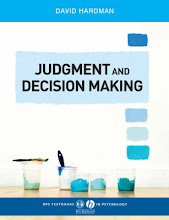Chapter 8 (page 89) included a brief description of the phenomenon of "proportion dominance", whereby describing something as a proportion of something else can have a bigger effect on judgment that describing it in absolute terms. Thus, in an example given by Paul Slovic and colleagues, people were willing to pay more for a programme that was described as saving 98% of 150 lives than a programme described as saving 150 lives. This has implications for assessment of risk, as described below.
According to a review of a new book (details below) on the flu pandemic of 1918-19, proportion dominance (although not named as such) is the reason why we tend not to remember this terrible event. The pandemic killed 50 million people worldwide. Over 200,000 people in Britain died within a 9 month period. Even at the time, in Britain at least, there seems to have been a 'grin and bear it' attitude. And what people remember now is the first world war that came before, but killed fewer people than the flu pandemic.
However, despite the massive death toll from the pandemic the actual rate of mortality among those who contracted the flu was very low, just 2-3%. This proportion, obvious to everyone at the time, seems to be the reason for people's matter-of-fact attitudes towards the pandemic at the time. That, in turn, means that it has been barely remembered.
Another review of the same book notes how the British government responded to the pandemic at the time. The Chief Medical Officer of the Local Government Board encouraged people to go about their business as usual. However, the medical officer of health for Manchester advised quarantine and keeping one's distance from others. The latter strategy was far more effective than the first. This matters today, because pandemic influenza - although not the most probable threat to Britain - is judged the biggest risk because of the potential impact. And because the government's usual response to disaster is to recommend 'business as usual'.
The book referred to above is Living with Enza: the forgotten story of Britain and the Great Flu Pandemic of 1918, by Mark Honigsbaum (Macmillan, £15.99).
The first review referred to is by Michael Worboys in the January 2009 issue of the BBC History magazine.
The second review referred to is by Tony Barnett in the February 2009 issue of Prospect magazine.
Showing posts with label flu pandemic. Show all posts
Showing posts with label flu pandemic. Show all posts
Thursday, 29 January 2009
Subscribe to:
Posts (Atom)
About Google Analytics
This website uses Google Analytics, a web analytics service provided by Google, Inc. (“Google”). Google Analytics uses “cookies”, which are text files placed on your computer, to help the website analyze how users use the site. The information generated by the cookie about your use of the website (including your IP address) will be transmitted to and stored by Google on servers in the United States . Google will use this information for the purpose of evaluating your use of the website, compiling reports on website activity for website operators and providing other services relating to website activity and internet usage. Google may also transfer this information to third parties where required to do so by law, or where such third parties process the information on Google's behalf. Google will not associate your IP address with any other data held by Google. You may refuse the use of cookies by selecting the appropriate settings on your browser, however please note that if you do this you may not be able to use the full functionality of this website. By using this website, you consent to the processing of data about you by Google in the manner and for the purposes set out above.



